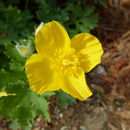pt-BR
nomes no trilho de navegação


Stylophorum diphyllum, commonly called the celandine poppy[1] or wood poppy,[2] is an herbaceous plant in the poppy family (Papaveraceae). It is native to North America, where it is found in the eastern United States and Ontario.[3] Its typical natural habitat is moist forests over calcareous rock, particularly in ravines.[4][5]
It is occasionally cultivated for its bright yellow flowers. The common name is derived from greater celandine (Chelidonium majus), a closely related European plant with similar flowers and leaves.
Stylophorum diphyllum is an herbaceous perennial. It grows to about 1.5 feet (0.46 m) tall, from underground rhizomes. Leaves are pinnately cut and lobed. They grow from the base of the plant, and in a pair at the top of the flowering stems. Apart from its normal sap, Stylophorum diphyllum produces a yellow-orange latex that stains.
In spring, the deep yellow flowers of the celandine poppy appear as a brilliant display on the forest floor. The flowers have 4 yellow petals, two soon-falling sepals, many yellow-orange stamens, and a single knobby stigma. They appear singly or in umbels of two to four flowers from early spring to early summer. The flowers issue from between a pair of leaves at the top of the flowering stems. They produce pollen, but no nectar.[5]
After fertilization, a bristly blue-green pod hangs below the leaves. Seeds with white elaiosomes ripen in midsummer and the pod opens by four flaps.
A patch of blooming plants at the Morton Arboretum in Illinois
Propagation is done by seed or by dividing established clumps in spring. It grows best in moist, high-humus soil, and prefers to be in the shade.[6] Division should be done early in the morning, preferably on a cloudy and mild day.
Plants are relatively long lived and readily self-seed under garden conditions.
Stylophorum diphyllum is a conservative species, and is somewhat uncommon throughout its range. Forest clearance is responsible for the loss of some stands of this species. As the wood poppy requires semi-shaded conditions, even selective logging can have negative effects by creating large openings that allow too much sun to reach the forest floor.
Due to its limited distribution in Canada, it is listed under Ontario's Endangered Species Act, 2007, which protects the species and its habitat.[7] One Ontario population of the wood poppy is in a conservation area.
Stylophorum diphyllum, commonly called the celandine poppy or wood poppy, is an herbaceous plant in the poppy family (Papaveraceae). It is native to North America, where it is found in the eastern United States and Ontario. Its typical natural habitat is moist forests over calcareous rock, particularly in ravines.
It is occasionally cultivated for its bright yellow flowers. The common name is derived from greater celandine (Chelidonium majus), a closely related European plant with similar flowers and leaves.
Stylophorum diphyllum is de botanische naam van een meerjarige plant in de papaverfamilie (Papveraceae). De plant is inheems in het midden en oosten van Noord-Amerika. Ze wordt daar Celandine poppy genoemd.
De plant wordt ongeveer een halve meter hoog. De bloemen hebben 4 gele kroonbladen en bloeien van april tot juni.
Het gebladerte is blauwgroen.
Haar habitat bestaat uit humeuze grond in matig vochtige tot vochtige bossen en langs de oevers van beken en stromen. Ze groeit in de schaduw en halfschaduw.
Wanneer de grond uitdroogt, "slapen" de planten in.
De indianen gebruikten het helder gele melksap uit de stengels als kleurstof.
Stylophorum diphyllum is de botanische naam van een meerjarige plant in de papaverfamilie (Papveraceae). De plant is inheems in het midden en oosten van Noord-Amerika. Ze wordt daar Celandine poppy genoemd.
De plant wordt ongeveer een halve meter hoog. De bloemen hebben 4 gele kroonbladen en bloeien van april tot juni.
Het gebladerte is blauwgroen.
Haar habitat bestaat uit humeuze grond in matig vochtige tot vochtige bossen en langs de oevers van beken en stromen. Ze groeit in de schaduw en halfschaduw.
Wanneer de grond uitdroogt, "slapen" de planten in.
Styloforum dwulistne (Stylophorum diphyllum) – gatunek rośliny z rodziny makowatych. Występuje we wschodniej części Ameryki Północnej. W stanie wegetatywnym bardzo podobny do introdukowanego do Ameryki Północnej i bardziej tu rozpowszechnionego glistnika jaskółcze ziele[3].
Bylina o wysokości do ok. 0,5 m, z łodygami prostymi lub rozgałęzionymi. Liście dolne długie na 0,5 m na ogonkach osiągających 0,2 m długości. Blaszka głęboko sieczna, podzielona na 5-7 klap wzdłuż brzegu karbowanych. Kwiaty na szypułach o długości od 2,5 do 8 cm. Działki kielicha do 15 mm długie, płatki korony żółte do 2-3 cm szerokie. Owoc – elipsoidalna i omszona torebka o długości 25-30 mm[3].
Kwitnie wiosną. Rośnie najczęściej w lasach liściastych, zwykle na zboczach[3].
Styloforum dwulistne (Stylophorum diphyllum) – gatunek rośliny z rodziny makowatych. Występuje we wschodniej części Ameryki Północnej. W stanie wegetatywnym bardzo podobny do introdukowanego do Ameryki Północnej i bardziej tu rozpowszechnionego glistnika jaskółcze ziele.
Stylophorum diphyllum là một loài thực vật có hoa trong họ Anh túc. Loài này được (Michx.) Nutt. miêu tả khoa học đầu tiên năm 1818.[1]
Stylophorum diphyllum là một loài thực vật có hoa trong họ Anh túc. Loài này được (Michx.) Nutt. miêu tả khoa học đầu tiên năm 1818.